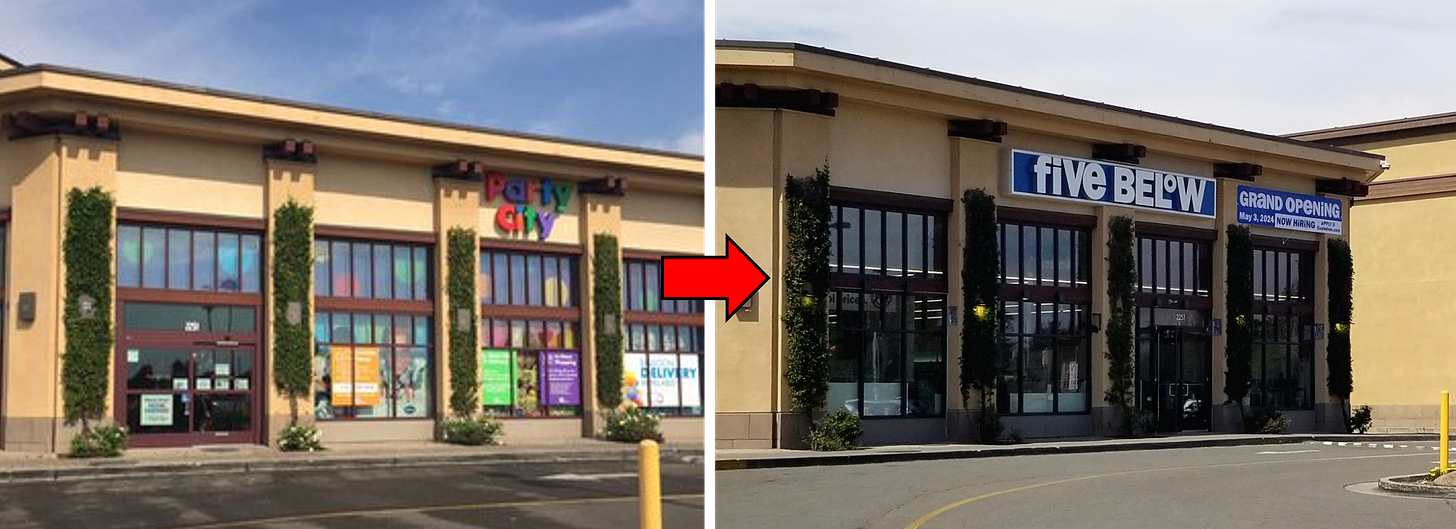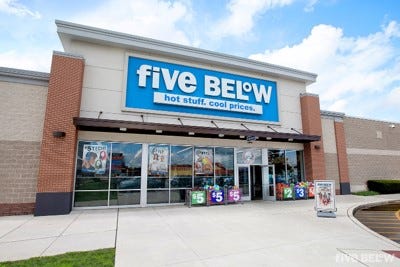Former Drugstores, Restaurants and Party City Leases: Where Five Below Is Sourcing Real Estate
Five Below is using creative strategies to secure sites and open hundreds of new stores in a tight market for retail real estate
Five Below FIVE 0.00%↑ opened 228 new stores in 2024.
Another 150 new store openings are planned in 2025.
But in a tight retail real estate market, where will Five Below find the ready-to-go buildings and sites that it will enable it to meet its store opening targets?
One retail real estate category that Five Below is pursuing?
Former drugstores.
Rite Aid, CVS and Walgreens have collectively shuttered more than 1,200 drugstore sites over the past two years, leaving plenty of available real estate.
In fact Five Below has already backfilled multiple shopping center suites that were once occupied by drugstores.
But Five Below is also now pursuing “freestanding” former drugstore buildings that are not attached to or part of shopping centers — and which, incidentally, comprise the majority of vacated drugstore sites.
One example is a former Rite Aid drugstore building in Philadelphia that is expected to open later this year as a new Five Below store.
Five Below is also pursuing other types of vacant freestanding buildings for adaptive reuse.
Like the new store that Five Below opened last year in Forsyth, Illinois.
It is a repurpose of a Hometown Buffet restaurant that closed in 2016.
But the biggest source of new store growth for Five Below in 2025 is expected to come from stores vacated as a result of the Party City bankruptcy.
Last month Five Below acquired the lease designation rights to 44 Party City locations in a bankruptcy auction.
If Five Below converts these former Party City sites to new stores they would account for ~1/3 of the Company’s planned new store openings in 2025.
Acquiring the leases of a bankrupt retailer is not a new strategy for Five Below.
In March 2023 Five Below was the top bidder in a bankruptcy auction for 17 Tuesday Morning store leases — and obtained near instant possession of the sites.
After some modest work and a quick re-brand, the former Tuesday Morning suites re-opened as Five Below stores.
To be sure, former drugstores, freestanding restaurants and shuttered Party City sites do not exactly match Five Below’s typical real estate criteria.
Most of the drugstores and Party City sites are 30-50% larger than the standard 8,000-10,000 square foot Five Below store prototype.
But many of the former Tuesday Morning sites were also larger.
Five Below executives noted that the additional size of the Tuesday Morning stores was an “immaterial difference” to the Company and provided it with opportunities to grow its “Five Beyond” section, or the part of the store that offers products at a price point that exceeds five dollars.
The leased sites, though, were generally in good condition and secured without negotiating new leases with landlords.
At the end of 2024 Five Below operated nearly 1,800 stores across 44 states.
But the Company sees a market opportunity for up to 3,500 stores.
So in addition to opening in unconventional real estate like former drugstore buildings and vacant restaurants, Five Below may also look to broaden its geographic and market criteria.
Like, perhaps, to seek locations that go beyond suburban shopping centers and instead into more urban centers and rural areas.












